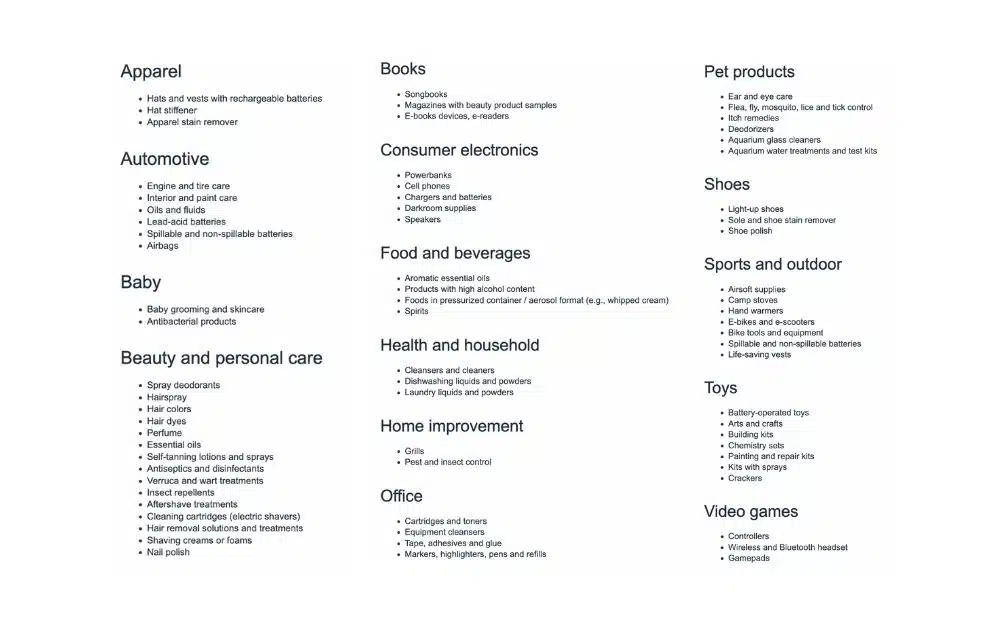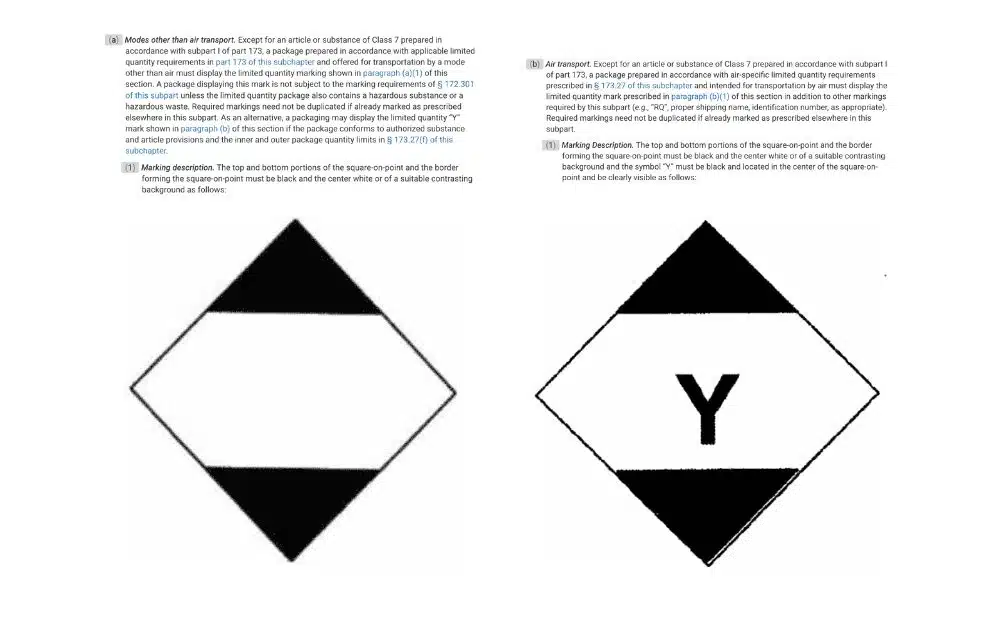What is a Limited Quantity Item?
A limited quantity item (or LQ item) might not sound like a big deal. But for sellers and shippers, getting it wrong can mean delays, penalties, or worse, product bans on major marketplaces.
Chances are you’ve brushed up against this hazmat-lite category without realizing it. It’s the fine print that decides whether your product ships smoothly or sets off compliance alarms. Understanding that distinction can make a serious impact on how you price, fulfill, and sell your products.
If you’re an ecommerce seller juggling with fulfillment and regulations, dealing with limited quantity items isn’t just background noise. It’s part of your bottom line.
What is a Limited Quantity Item?
A limited quantity item is a product that contains hazardous materials in such small amounts that it qualifies for reduced shipping regulations under U.S. Department of Transportation (DOT) and international standards.
These rules are especially useful for sellers who ship common goods like aerosols, nail polish, or small batteries. In short, items that may be flammable or pressurized, but don’t pose a serious threat when packaged and labeled properly.
Amazon classifies these under the Amazon hazmat program, specifically flagging such items as “dangerous goods in limited quantities.” Understanding whether your product falls into this category is key to avoiding listing errors, shipping delays, and even account suspensions.
Let’s take aerosols for instance, which are one of the most common limited quantity items in ecommerce. According to data from PHMSA, about 82% of aerosol shipments are transported by ground, taking full advantage of the less stringent LQ guidelines for road transport. The remaining 18% go by air, which comes with tighter packaging and documentation requirements.
Here’s a look at the aerosol supply chain from the Aerosol Transportation Risk Assessment:

Notice how the product flows through various stages: warehouses, freight forwarders, intermodal facilities, and even aircraft. This flow must comply with limited quantity rules at every stage to ensure smooth and legal transport.
Limited Quantity Item Examples
Some items are dangerous enough to require full hazmat documentation, while others, if packaged in small amounts, qualify as a limited quantity item and can ship under relaxed regulations.
Here are some of the most common examples you’ll see in warehouses, fulfillment centers, or Amazon’s dangerous goods program:
Aerosol Products
Aerosols are one of the most frequently shipped limited quantity items. They’re pressurized and flammable, but when packed properly in small units, they fall neatly under LQ shipping rules.
Nail Polish and Cosmetics
Nail polishes, makeup removers, and perfumes often contain flammable alcohols or solvents. In small bottles (typically under 1 liter), they can be shipped as LQIs both by ground and, with stricter rules, by air.
Household Cleaners
Bleach, disinfectants, and drain cleaners may contain corrosive or flammable materials. If shipped in small bottles with proper cushioning and LQ labeling, they often qualify for reduced documentation under DOT or International Air Transport Association (IATA) standards.
Paint and Paint-Related Products
Oil-based paints, varnishes, and adhesives often contain flammable solvents. Many 3PL providers and shipping partners handle these as limited quantity shipments when container size and net weight meet the regulatory limits.

What Are the Rules for Shipping Limited Quantity Items?
There are clear rules you need to follow when shipping LQIs. These regulations come from both US law and carrier-specific guidelines, and they’re designed to ensure that lower-risk hazardous goods are still packed and labeled safely.
At the heart of it is 49 CFR 172.315, which outlines how limited quantity packages must be marked and handled. Here’s a breakdown of what that really means for sellers and shippers:
Packaging Requirements
To qualify for the limited quantity exception, your product must:
- Contain hazardous material within allowable volume and weight limits (varies by hazard class.)
- Be placed inside strong, leakproof inner packaging.
- Be enclosed in a durable, pressure-tested outer package.
- Be able to withstand drop tests and stacking pressure.
In short, your packaging needs to protect against leaks, spills, and rough handling—especially if it’s going through a 3PL warehouse or multiple fulfillment hubs.
Limited Quantity Labeling
One of the most important requirements is correct limited quantity labeling. U.S. ground shipments must display the standard black-and-white diamond symbol used for limited quantity items. For air shipments, a stricter version (the Y-marked LQ label) is required.

Incorrect or missing labels can lead to shipment rejections, unexpected delays, or even fines. This is particularly critical on platforms like Amazon, where hazmat compliance is tightly monitored and enforced.
In addition to marking rules, shipping by air comes with tighter restrictions compared to the more flexible requirements for ground transport.
Ground Shipping
Most limited quantity items shipped by road:
- Don’t require shipping papers
- Don’t need hazmat training for drivers
- Don’t need UN numbers displayed on the box
Ground shipping is best for sellers who ship domestically, use services like Amazon FBA or FBM, and want lower-cost fulfillment without extensive paperwork.
Air Shipping
Governed by IATA (not just DOT), air transport comes with:
- Stricter packaging rules (e.g., higher pressure resistance)
- Quantity and volume restrictions per package
- A Shipper’s Declaration of Dangerous Goods might be necessary, especially when sending items by air under certain hazard classifications
- Carrier-specific rules (e.g., UPS and FedEx often require pre-approval)
Documentation and SDS
Even though the paperwork is reduced, you still need to maintain:
- Product Safety Data Sheets (SDS)
- Proper internal documentation in case of audit
- Clear markings in your warehouse or fulfillment center
If you’re selling through Amazon, you’ll be prompted to submit this data during the listing process for hazmat items. If you fail to provide the right documentation, your product might be flagged as “blocked” or made ineligible for FBA.
Tips to Use LQI
Here are a few ways you can stay compliant and make limited quantity work for your business:
Master Compliance to Avoid Listing Bans
Staying compliant means aligning your packaging, labeling, and documentation with the latest regulations and the requirements of your sales platform. Doing so is especially important for Amazon hazmat rules.
It’s not just about meeting regulations; it’s also about reinforcing your credibility with customers. According to a 2024 survey, 91% of consumers believe brands have a responsibility to build trust, and 46% say they purchase more from brands they trust.

When your labeling, documentation, and safety practices are clear and consistent, you’re not just checking a box, you’re reinforcing your credibility with buyers.
- Best Practice. Use Amazon’s hazmat review process to submit your SDS and check product classification before listing. If eligible for limited quantity shipping, confirm your packaging and labeling follow guidelines.
Use LQI to Reduce Shipping Costs
Merchant-fulfilled shipments, particularly those sent by ground, can take advantage of the relaxed regulations that apply to limited quantity items. This can help lower shipping costs and simplify packaging.
Many businesses unknowingly ship small-volume hazmat items (e.g., 200ml bottles of nail polish, small paint cans, aerosols) as fully regulated when they could legally be shipped under limited quantity, resulting in:
- Unnecessary carrier fees
- Slower fulfillment and returns
- Stricter warehouse handling
- Lower profit margins
It’s crucial to note, however, that for FBA sellers, Amazon still applies hazmat classification and related requirements, even if the product qualifies under Limited Quantity rules.
- Best Practice. Audit your product catalog and shipping methods. If you’re paying full hazmat rates for small quantities, see if you can downsize or repackage to qualify under LQ rules.
Bundle Strategically to Boost Sales and Efficiency
One of the most powerful but underused benefits of the limited quantity exception is the ability to bundle small hazardous goods into a single package without triggering full hazmat shipping requirements. Think a trio of nail polishes, mini spray bottles, or paint tubes.
As long as the total volume per inner and outer container remains within LQ limits and proper packaging is used, sellers can move more products per order with less regulatory friction.
This approach is ideal for ecommerce sellers looking to increase average order value (AOV), improve logistics efficiency, and create promos that sell faster.
- Best Practice. Before bundling, create a packaging map that lists: the UN number and hazard class of each item; volume per unit; and total volume and net weight per box. Have your logistics or compliance team pre-approve bundles using this map to ensure they remain within LQ parameters.
The Bottom Line
A limited quantity item status can be a useful tool for cutting costs and simplifying logistics. From cutting shipping costs to unlocking smoother fulfillment, LQI status offers strategic benefits, if you understand the rules and apply them correctly.
But here’s the catch: it’s not just about slapping on a label. From freight carriers to online marketplaces, each system has its own criteria for handling limited quantity items. LQI can reduce friction for merchant-fulfilled shipments, but it won’t bypass hazmat rules for FBA.
Getting LQI wrong could mean penalties or delays but getting it right could mean better profit margins and faster delivery.
If you need help navigating hazmat and LQI rules on Amazon, reach out to us! Trusted by brands worldwide, our ecommerce consultants can help you optimize your ecommerce business for optimum growth.
Author
 Carla Bauto Deña is a journalist and content writer producing stories for traditional and digital media. She believes in empowering small businesses with the help of innovative solutions, such as ecommerce, digital marketing, and data analytics.
Carla Bauto Deña is a journalist and content writer producing stories for traditional and digital media. She believes in empowering small businesses with the help of innovative solutions, such as ecommerce, digital marketing, and data analytics.
The post What is a Limited Quantity Item? appeared first on AMZ Advisers.



